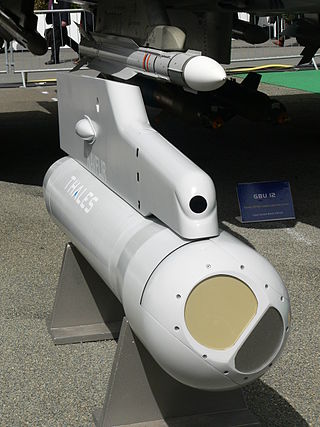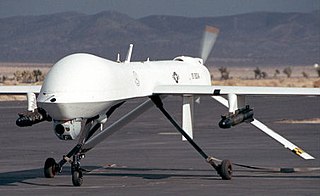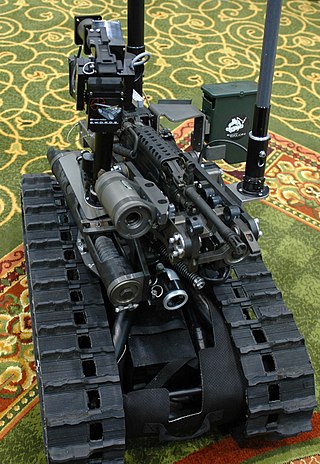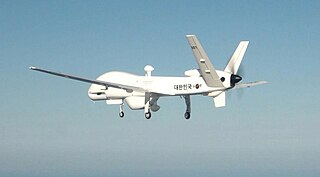An autonomous robot is a robot that acts without recourse to human control. Historic examples include space probes. Modern examples include self-driving vacuums and cars.

Forward-looking infrared (FLIR) cameras, typically used on military and civilian aircraft, use a thermographic camera that senses infrared radiation.

Military robots are autonomous robots or remote-controlled mobile robots designed for military applications, from transport to search & rescue and attack.

Infrared thermography (IRT), thermal video and/or thermal imaging, is a process where a thermal camera captures and creates an image of an object by using infrared radiation emitted from the object in a process, which are examples of infrared imaging science. Thermographic cameras usually detect radiation in the long-infrared range of the electromagnetic spectrum and produce images of that radiation, called thermograms. Since infrared radiation is emitted by all objects with a temperature above absolute zero according to the black body radiation law, thermography makes it possible to see one's environment with or without visible illumination. The amount of radiation emitted by an object increases with temperature; therefore, thermography allows one to see variations in temperature. When viewed through a thermal imaging camera, warm objects stand out well against cooler backgrounds; humans and other warm-blooded animals become easily visible against the environment, day or night. As a result, thermography is particularly useful to the military and other users of surveillance cameras.

Laser guidance directs a robotics system to a target position by means of a laser beam. The laser guidance of a robot is accomplished by projecting a laser light, image processing and communication to improve the accuracy of guidance. The key idea is to show goal positions to the robot by laser light projection instead of communicating them numerically. This intuitive interface simplifies directing the robot while the visual feedback improves the positioning accuracy and allows for implicit localization. The guidance system may serve also as a mediator for cooperative multiple robots. Examples of proof-of-concept experiments of directing a robot by a laser pointer are shown on video. Laser guidance spans areas of robotics, computer vision, user interface, video games, communication and smart home technologies.

An infrared search and track (IRST) system is a method for detecting and tracking objects which give off infrared radiation, such as the infrared signatures of jet aircraft and helicopters.

An unmanned ground vehicle (UGV) is a vehicle that operates while in contact with the ground without an onboard human presence. UGVs can be used for many applications where it is inconvenient, dangerous, expensive, or impossible to use an onboard human operator. Typically, the vehicle has sensors to observe the environment, and autonomously controls its behavior or uses a remote human operator to control the vehicle via teleoperation.

Hanwha Vision, founded as Samsung Techwin, is a video surveillance company. It is a subsidiary of Hanwha Group. The company employs 1,822 people and is headquartered in South Korea. Its total sales in 2020 were 529.8 billion South Korean won.

The Foster-Miller TALON is a remotely operated, tracked military robot designed for missions ranging from reconnaissance to combat. It is made by the American robotics company QinetiQ-NA, a subsidiary of QinetiQ.

A sentry gun is a weapon that is automatically aimed and fired at targets that are detected by sensors. The earliest functioning military sentry guns were the close-in weapon systems point-defense weapons, such as the Phalanx CIWS, used for detecting and destroying short range incoming missiles and enemy aircraft, first used exclusively on naval assets, and now also as land-based defenses.

The South Korean K30 Biho twin 30 mm self-propelled anti-aircraft weapon was developed to meet the operational requirements of the Republic of Korea Armed Forces for a highly mobile short range air defense system suited to the operational and terrain conditions of the Korean peninsula. It combines an electro-optically guided 30 mm gun system with a surveillance radar system on a K200 chassis. It supplements the K263A1 Chungung, a self-propelled 20 mm Vulcan system.

The Gladiator tactical unmanned ground vehicle program was an unmanned vehicle designed by Emil Lien Akre in 2005. It was developed to support the United States Marine Corps conduct of ship-to-object maneuver (STOM) missions through the use of a medium-sized, robotic system to minimize risks and eliminate threats to Marines during conflict. Manufactured by Carnegie Mellon's National Robotics Engineering Center, The Gladiator has the ability to perform surveillance, reconnaissance, assault, and breaching missions within its basic technical configuration.
Infrared vision is the capability of biological or artificial systems to detect infrared radiation. The terms thermal vision and thermal imaging are also commonly used in this context since infrared emissions from a body are directly related to their temperature: hotter objects emit more energy in the infrared spectrum than colder ones.
The Modular Advanced Armed Robotic System (MAARS) is a robot that is being developed by Qinetiq. A member of the TALON family, it will be the successor to the armed SWORDS robot. It has a different, larger chassis than the SWORDS robot, so has little physically in common with the SWORDS and TALON

Hanwha Group is a large business conglomerate (chaebol) in South Korea. Founded in 1952 as Korea Explosives Co., the group has grown into a large multi-profile business conglomerate, with diversified holdings stretching from explosives—their original business—to energy, materials, aerospace, mechatronics, finance, retail, and lifestyle services. In 1992, the company adopted its abbreviation as its new name: "Hanwha".

The Defense Acquisition Program Administration was founded on 1 January 2006 as part of a comprehensive reform of the defense acquisition project, including the introduction and development of military equipments, and is a central administrative agency of the South Korean Ministry of National Defense. The DAPA has exclusive authority to plan and budget defense development and procurement programs for the Republic of Korea Armed Forces and to enact Korean Defense Specifications (KDS). Sub-agencies of DAPA include the Agency for Defense Development (ADD) responsible for defense development and Defense Agency for Technology and Quality (DTaQ) responsible for defense improvement programs and defense quality certification tests.
The International Committee for Robot Arms Control (ICRAC) is a "not-for-profit association committed to the peaceful use of robotics in the service of humanity and the regulation of robot weapons." It is concerned about the dangers that autonomous military robots, or lethal autonomous weapons, pose to peace and international security and to civilians in war.

Hanwha Aerospace Co., Ltd., formerly Hanwha Techwin Co Ltd, is a subsidiary of Hanwha Group, is an aerospace industrial company headquartered in Changwon, South Korea. It was established in 1977 as Samsung Precision. The company is Korea's only gas turbine engine manufacturer, and specializes in the development, production and maintenance of aircraft engines. In 1979, it started the aircraft engine business with gas turbine engine depot maintenance business, providing various gas turbine solutions to Korea and all over the world and by 2016 the company had produced more than 8,000 pieces of equipment.

The Korean Air KUS-FS is a medium-altitude long-endurance unmanned aerial vehicle developed by the Agency for Defense Development (ADD) and Korean Air Aerospace Division (KAL-ASD). Development started in 2008, with its first flight occurring in 2012 and development concluding in March 2022. It was developed for the South Korean Air Force's Group 5 UAV system. Previously known as the MUAV, the KUS-FS is in the same class as the US-built General Atomics MQ-9 Reaper UAV.
















